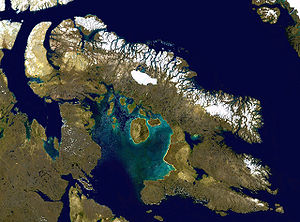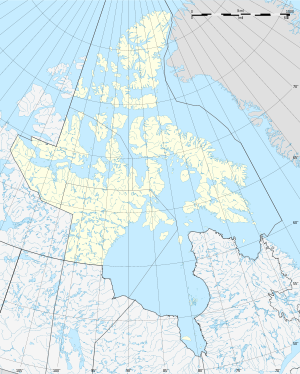Amadjuak Lake
| Amadjuak Lake | ||
|---|---|---|

|
||
| Amadjuak Lake is the lower of the two lakes shown, the upper one is Nettilling Lake | ||
| Geographical location | on Baffin Island | |
| Drain | Amadjuak River | |
| Islands | Victoria Island | |
| Data | ||
| Coordinates | 64 ° 55 ′ N , 71 ° 0 ′ W | |
|
|
||
| Altitude above sea level | 113 m | |
| surface | 3 115 km² | |
| length | 80 km | |
| width | 45 km | |
Located on Baffin Island south of the Arctic Circle , Amadjuak Lake is 3115 km² in area, more than 80 km in length and 45 km in width, making it the third largest freshwater lake in the Canadian territory of Nunavut .
The lake is known for a peculiarity in the Arctic - 30 m high limestone cliffs, washed out by the sea waves, towering over it and falling from the surrounding plain. The lake probably got its name from them: Angmaakjuak, as the Inuit call it, means "large flint ".
The lake is 113 m above sea level. d. M. 75 km northeast of the Hudson Strait and 125 km northwest of Iqaluit on the edge of the Great Plain of Koukdjuak and forms together with the largest lake on Baffin Island, Nettilling Lake , into which it flows northwards over the Amadjuak River , and that south of it adjoining Mingo Lake and a multitude of smaller bodies of water, ponds and river impoundments form an extensive lake area, which eventually flows over the narrow Koukdjuak River into the Foxe Basin .
The Koukdjuak plain was first settled more than 4,000 years ago. Between 1924 and 1926 Joseph Dewey Soper (1893-1982) stayed as a government commissioner in the lake area and explored the region from the Hudson Strait to Nettilling Lake. Because of the abundance of caribou and fish, many Inuit had their camps here. However, the area has not been permanently inhabited for about five decades; the Inuit now live in the settlements of Cape Dorset and Kimmirut and only come to Lake Amadjuak to hunt and fish in their free time.
As in Nettilling Lake, there are three species of fish in Lake Amadjuak: Arctic char ( Salvelinus alpinus ), nine-spined stickleback ( Pungitius pungitius ) and three-spined stickleback ( Gasterosteus aculeatus ).
The tundra around the entire lake area serves caribou herds as a feeding place and region for calving. The most extensive concentration of caribou in the Canadian archipelago develops here in the spring and early summer months, and the main migration route for these animals passes Lake Amadjuak in the spring and fall.

